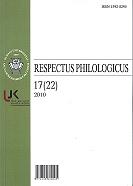KAS BENDRA TARP DIEVMEDIS IR DIEVAS, DIEVAI?
WHAT DOES DIEVMEDIS (GOD’S TREE) HAVE IN COMMON WITH GOD(S)?
Author(s): Bernd Gliwa, Daiva ŠeškauskaitėSubject(s): Language and Literature Studies
Published by: Vilniaus Universiteto Leidykla
Keywords: lietuvių1; latvių kalba2; tautosaka3; simbolis4; diemedis5; dievo medis6; Artemisia abrotanum7;
Summary/Abstract: Lithuanian diemedis and Latvian dievakoks represent the most frequent vernacular names of southernwood Artemisia abrotanum. These plant names appear quite frequently in Lithuanian and more seldom in Latvian folklore, especially in folk songs and speeches given during traditional wedding ceremonies. Here, southernwood goes as symbol of the groom or any young man. Quite often, the properties mentioned point to a tree, not a shrub. For example, the tree diemedis is suitable for a falcon or peacock to take a seat. Literally both diemedis and dievakoks mean God’s tree. The plant, however, is a small peren¬nial shrub. The paper raises several questions. Why was the shrub called “tree”? What is the relation between God and the shrub? What is the reason that the shrub became symbolically loaded and used during ceremonies? Lithuanian and Latvian names of southern¬wood appear as early as the 17th century in the earliest dictionaries. An overview of vernacular names of the plant in many European languages shows a picture as follows. While in the South, West and North Europe most names are loans based on Latin abrotanum and remakings of them by means of folk etymology, other names refer to officinal use or smell. However, in the Eastern Europe, namely, in all Slavic and Baltic languages the plant names meaning “God’s tree” dominate. Moreover, we can come across such instances in the Romanian and Hungarian languages. Their origin seems to be Old Greek habrotanon ‘Artemisia sp.’ of unknown origin, which was related to ábrotos ‘immortal, divine’ in folk etymology. In Slavic environment, the plant, thus being a divine plant, was subsequently identified with the already exist¬ing “God’s tree” in folk belief and custom. When brought to the Balts, the plant was identified and its name was adopted. Lithuanian dievo medis is a calque of Slavic origin. As the old God’s tree is described in folklore, it may be seen as a trace of the world tree concept, which is used as a ritual place during wedding ceremonies. Other views are possible, of course. Some texts show the changes indicated by the real plant onto the view of God’s tree; for example, diemedžio krūmelis ‘God’s tree shrub’, or the growing part in the bed of flowers.
Journal: Respectus Philologicus
- Issue Year: 2010
- Issue No: 17 (22)
- Page Range: 205-218
- Page Count: 14
- Language: Lithuanian

